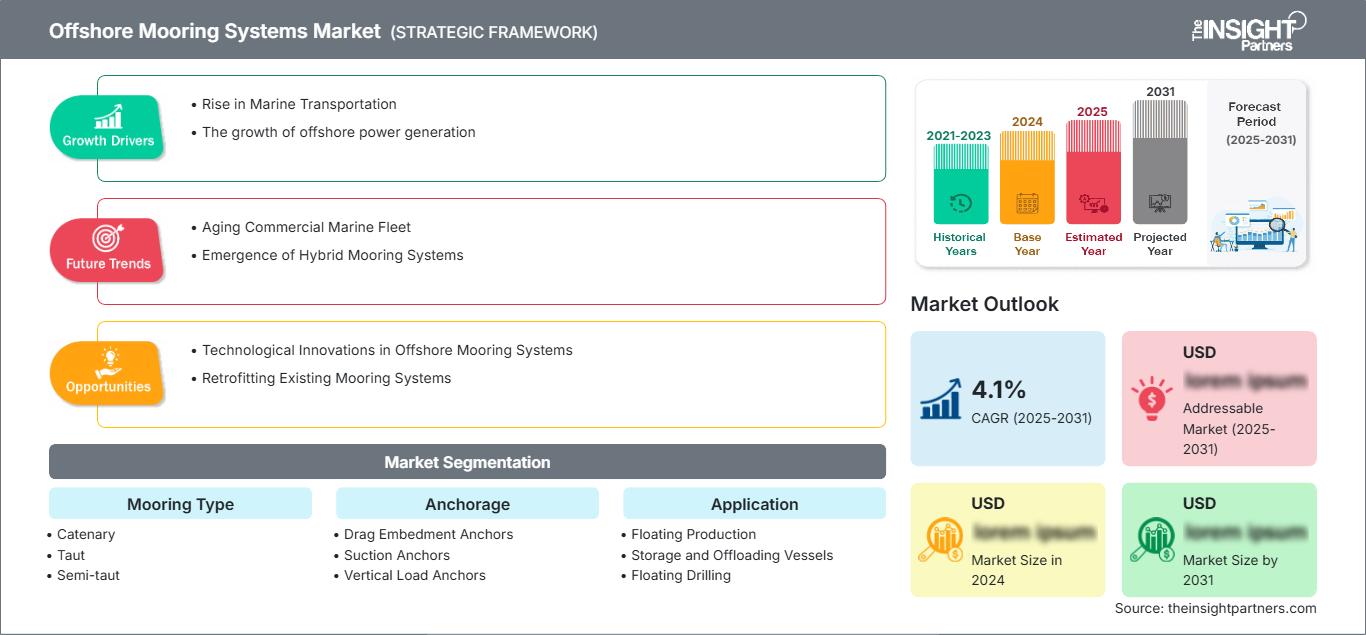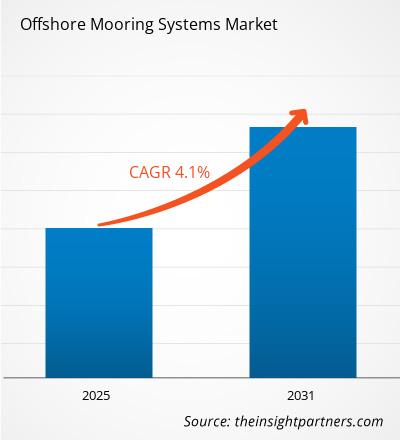Se prevé que el mercado de sistemas de amarre en alta mar registre una tasa de crecimiento anual compuesta (TCAC) del 4,1% entre 2025 y 2031, con un tamaño de mercado que se expandirá de XX millones de dólares estadounidenses en 2024 a XX millones de dólares estadounidenses en 2031.
El informe se segmenta por tipo de amarre ( catenario , tenso, semitenso, extendido, de punto único y de posicionamiento dinámico), anclaje ( anclajes de arrastre, de succión y de carga vertical) y aplicación (buques flotantes de producción, almacenamiento y descarga ( FPSO ), buques flotantes de perforación, producción, almacenamiento y descarga ( FDPSO ), buques flotantes de gas natural licuado ( FLNG ), plataformas de patas tensadas, plataformas semisumergibles, plataformas Spar y otros). El análisis global se desglosa a su vez por regiones y países principales. El informe presenta el valor en USD para el análisis y los segmentos mencionados.
Finalidad del informe
El informe sobre el mercado de sistemas de amarre en alta mar, elaborado por The Insight Partners, tiene como objetivo describir el panorama actual y el crecimiento futuro, los principales factores impulsores, los desafíos y las oportunidades. Esto proporcionará información valiosa a diversos actores del sector, tales como:
- Proveedores/fabricantes de tecnología: Para comprender la evolución de la dinámica del mercado y conocer las posibles oportunidades de crecimiento, lo que les permitirá tomar decisiones estratégicas informadas.
- Inversores: Realizar un análisis exhaustivo de las tendencias relativas a la tasa de crecimiento del mercado, las proyecciones financieras del mercado y las oportunidades que existen a lo largo de la cadena de valor.
- Organismos reguladores: Regular las políticas y controlar las actividades en el mercado con el objetivo de minimizar los abusos, preservar la confianza de los inversores y mantener la integridad y la estabilidad del mercado.
Segmentación del mercado de sistemas de amarre en alta mar
Tipo de amarre
- De cadena
- Tirante
- Semitenso
- Desparramar
- Punto único
- Posicionamiento dinámico
Anclaje
- Anclajes de inserción de arrastreEmbedment Anchors
- Anclajes de succión
- Anclajes de carga vertical
Solicitud
- Producción flotante
- Buques de almacenamiento y descarga
- Perforación flotante
- Producción
- Buques de almacenamiento y descarga
- Buques flotantes de gas natural licuado
- Plataforma de patas tensadas
- Semisumergibles
- Plataformas Spar
Geografía
- América del norte
- Europa
- Asia-Pacífico
- América del Sur y Central
- Oriente Medio y África
Obtendrá personalización gratuita de cualquier informe, incluyendo partes de este informe, análisis a nivel de país y paquetes de datos de Excel. Además, podrá aprovechar excelentes ofertas y descuentos para empresas emergentes y universidades.
Mercado de sistemas de amarre en alta mar: Perspectivas estratégicas

-
Obtenga las principales tendencias clave del mercado que se describen en este informe.Esta muestra GRATUITA incluirá análisis de datos, que abarcarán desde tendencias de mercado hasta estimaciones y pronósticos.
Factores que impulsan el crecimiento del mercado de sistemas de amarre en alta mar
- Auge del transporte marítimo: La creciente preferencia por el transporte marítimo se ha incrementado en los últimos años debido a sus tarifas más económicas, su idoneidad para grandes volúmenes de mercancías y su fácil conexión con otras partes del mundo. Una de las principales ventajas del transporte marítimo es la capacidad de las navieras para transportar cargas sobredimensionadas y pesadas, comúnmente conocidas como carga fraccionada o carga no transportada en remolque (NIT). Vehículos de gran tamaño, equipos, materiales de construcción y otros artículos pueden transportarse como carga. Por lo tanto, se espera que el auge del transporte marítimo impulse el mercado de sistemas de amarre en alta mar en los próximos años.
- El crecimiento de la generación de energía marina: Se espera que el aumento de la inversión en proyectos de energía eólica marina, producción de petróleo y gas en alta mar y proyectos de energía oceánica impulse la demanda de buques, lo que a su vez impulsará el crecimiento del mercado de sistemas de amarre en alta mar en los próximos años.
Tendencias futuras del mercado de sistemas de amarre en alta mar
- Flota marítima comercial envejecida: En casi todos los países, la mayor parte de la flota de buques comerciales es antigua. Según datos publicados por las Naciones Unidas en 2023, la edad promedio de los buques a nivel mundial era de 22,2 años, y más de la mitad tiene más de 15 años. Además, según datos de la Oficina de Transporte de EE. UU. de 2021, había aproximadamente 27 000 embarcaciones en ese país con más de 15 años de antigüedad. Por lo tanto, la necesidad de renovar la flota comercial aumentará, lo que se prevé que genere oportunidades de crecimiento para el mercado de sistemas de amarre en alta mar durante el período de pronóstico.
- Auge de los sistemas de amarre híbridos: El auge de los sistemas de amarre híbridos, que combinan métodos de amarre tradicionales con tecnologías de posicionamiento dinámico, está ganando terreno. Esta tendencia mejora la flexibilidad operativa y la adaptabilidad a las distintas condiciones ambientales.
Oportunidades de mercado de sistemas de amarre en alta mar
- Innovaciones tecnológicas en sistemas de amarre marino: A lo largo de las décadas, los avances tecnológicos han propiciado mejoras significativas en los sistemas de amarre. El objetivo principal ha sido aumentar la eficiencia, reducir el tamaño y mejorar la fiabilidad de estos sistemas. Este cambio ha permitido una mayor flexibilidad y eficiencia en la generación de energía para satisfacer las diversas necesidades de carga eléctrica a bordo de los buques. Por consiguiente, se prevé que las innovaciones tecnológicas sean la tendencia clave del mercado.
- Modernización de sistemas de amarre existentes: La modernización de los sistemas de amarre marinos existentes con tecnologías avanzadas ofrece importantes oportunidades. Las empresas pueden dirigirse a operadores que buscan mejorar el rendimiento y la seguridad de sus soluciones de amarre actuales.
Perspectivas regionales del mercado de sistemas de amarre en alta mar
Los analistas de The Insight Partners han explicado en detalle las tendencias y los factores regionales que influyen en el mercado de sistemas de amarre marino durante el período de previsión. Esta sección también analiza los segmentos y la geografía del mercado de sistemas de amarre marino en Norteamérica, Europa, Asia Pacífico, Oriente Medio y África, y Sudamérica y Centroamérica.
Alcance del informe de mercado de sistemas de amarre en alta mar
| Atributo del informe | Detalles |
|---|---|
| Tamaño del mercado en 2024 | XX millones de dólares estadounidenses |
| Tamaño del mercado para 2031 | XX millones de dólares estadounidenses |
| Tasa de crecimiento anual compuesto global (2025 - 2031) | 4,1% |
| Datos históricos | 2021-2023 |
| período de previsión | 2025-2031 |
| Segmentos cubiertos |
Por tipo de amarre
|
| Regiones y países cubiertos |
América del norte
|
| Líderes del mercado y perfiles de empresas clave |
|
Densidad de los actores del mercado de sistemas de amarre en alta mar: comprensión de su impacto en la dinámica empresarial
El mercado de sistemas de amarre en alta mar está experimentando un rápido crecimiento, impulsado por la creciente demanda de los usuarios finales debido a factores como la evolución de las preferencias de los consumidores, los avances tecnológicos y una mayor conciencia de las ventajas del producto. A medida que aumenta la demanda, las empresas amplían su oferta, innovan para satisfacer las necesidades de los consumidores y aprovechan las nuevas tendencias, lo que impulsa aún más el crecimiento del mercado.

- Obtenga una visión general de los principales actores del mercado de sistemas de amarre en alta mar.
Puntos clave de venta
- Cobertura integral: El informe abarca de forma exhaustiva el análisis de productos, servicios, tipos y usuarios finales del mercado de sistemas de amarre en alta mar, proporcionando una visión holística.
- Análisis de expertos: El informe se elabora a partir del profundo conocimiento de expertos y analistas del sector.
- Información actualizada: El informe garantiza su relevancia para el negocio gracias a su cobertura de información reciente y tendencias de datos.
- Opciones de personalización: Este informe se puede personalizar para satisfacer las necesidades específicas del cliente y adaptarse adecuadamente a las estrategias comerciales.
Por lo tanto, el informe de investigación sobre el mercado de sistemas de amarre en alta mar puede ayudar a impulsar la comprensión del panorama de la industria y sus perspectivas de crecimiento. Si bien existen algunas preocupaciones válidas, los beneficios generales de este informe tienden a superar las desventajas.
- Análisis histórico (2 años), año base, pronóstico (7 años) con CAGR
- Análisis PEST y FODA
- Tamaño del mercado, valor/volumen: global, regional y nacional
- Industria y panorama competitivo
- Conjunto de datos de Excel
Informes recientes
Testimonios
Razón para comprar
- Toma de decisiones informada
- Comprensión de la dinámica del mercado
- Análisis competitivo
- Información sobre clientes
- Pronósticos del mercado
- Mitigación de riesgos
- Planificación estratégica
- Justificación de la inversión
- Identificación de mercados emergentes
- Mejora de las estrategias de marketing
- Impulso de la eficiencia operativa
- Alineación con las tendencias regulatorias






















 Obtenga una muestra gratuita para - Mercado de sistemas de amarre en alta mar
Obtenga una muestra gratuita para - Mercado de sistemas de amarre en alta mar